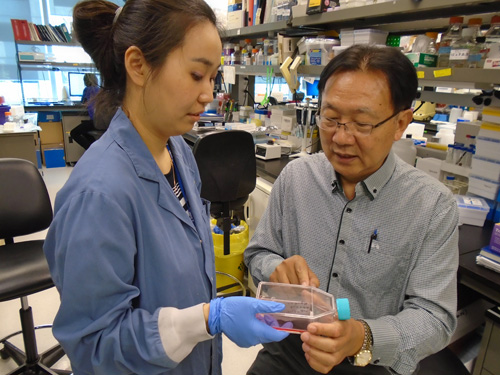
Hyunhee Kim, Ph.D. student (L) and Dr. Mingyao Liu, TGRI Senior Scientist, observe human lung cells which they used in experiments to reduce injury in cells. (Photo: UHN)
A novel tiny gold particle has been developed by Toronto General Research Institute (TGRI) scientists that can penetrate cell membranes to deliver drugs directly into cell targets.
While gold nanoparticles – so tiny that 50,000 of them could fit across the width of a human hair – have been used to deliver peptide drugs which attach to a cell's surface, the TGRI team, led by senior scientists Drs. Mingyao Liu and Shaf Keshavjee, developed a strategy which allows the nanoparticle to penetrate into a cell.
Once inside the cell, the drug blocks a major protein-to-protein interaction, preventing a molecular signal that triggers an inflammatory response within cells.
The findings have been tested in cell culture and rat models and are published in
Nanoscale, 2015, 7.
Complications following transplant surgery
More than 80 per cent of potential donor lungs are injured and show inflammation due to complications, and cannot be used for transplantation. Inflammation and organ rejection are the two main complications after transplant surgery.
"Preventing lung injury, especially in the first 72 hours after surgery, would have a significant impact on survival and quality of life after transplantation," says Dr. Keshavjee, Director, Toronto Lung Transplant Program, UHN Surgeon-in-Chief and Director, Latner Thoracic Research Laboratories.
"We are working on techniques to modify, protect and repair the donor lung so that it is better able to deal with the stress imposed upon it by the transplantation process."
Bench to bedside
A step-by-step pipeline of drug discovery and drug delivery for acute lung injury and lung transplantation has been developed by the Liu-Keshavjee teams with cell culture studies, screening of multiple compounds, pre-clinical testing and clinical trial expertise, which facilitates the translation of research from bench to bedside.
The researchers first modified a gold nanoparticle and then coated it with short peptides – chains of amino acids that are the building blocks of proteins – so that it would remain stable to deliver the peptide drug into the cell. Once there, the drug blocks a specific protein called PKCdelta from triggering an inflammatory response.
"We formulated this nanotechnology to deliver drugs into a cell in a highly specific, efficient way, with minimal side effects," says Dr. Liu, Senior Scientist at TGRI, Director, Institute of Medical Science and Professor of Surgery, Faculty of Medicine, University of Toronto.
"This novel approach could open up new ways of treating lung and other diseases."
A golden solution
Previous studies by the Liu-Keshavjee Latner Thoracic Research Labs showed that inhibiting the PKCdelta signaling pathway resulted in reduced lung injury and cell survival. The work was published in the
American Journal of Transplantation.
The researchers went on to show that the gold nanoparticle-PKCdelta inhibitor protected donor rat lungs from injury for a longer time of ischemia – or lack of blood flow - with a much lower dose. The PKCdelta-inhibitor-treated rat lungs also had better outcomes on a number of tests, including how well they were able to take in oxygen, and lower inflammation.
This research was funded by CIHR grants. Next steps include testing the therapeutic effect of the gold nanoparticle-PKCdelta inhibitor in further pre-clinical trials.
